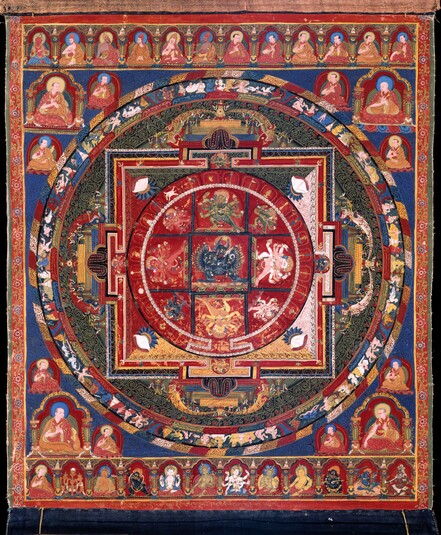
Item: Mandala of Vajrabhairava (Buddhist Deity) - Solitary (Ekavira)
| Origin Location | Tibet |
|---|---|
| Date Range | 1500 - 1599 |
| Lineages | Sakya, Ngor (Sakya) and Buddhist |
| Material | Ground Mineral Pigment on Cotton |
| Collection | Rubin Museum of Art |
Classification: Deity
Appearance: Animal-Feature
Gender: Male
Vajrabhairava Thirteen Deity Mandala (Tibetan: dor je jig je).
Vajrabhairava is one of the most visually complex of all the different Tantric Buddhist deities. He is easily recognized by his large central buffalo face, multiple heads, arms and legs. From amongst the many lineages of practice to enter Tibet the main transmissions of Vajrabhairava were those of the two translators Rwa Lotsawa and Mal Lotsawa. Although practiced early on in Tibet by the Sakya and Kagyu Traditions, it was Tsongkapa, founder of the Gelug Tradition, who instituted Vajrabhairava as the principal Gelugpa meditation practice. For this reason large quantities of paintings and sculpture were produced for the followers that have now over centuries accumulated in Western museums and collections.
In appearance Vajrabhairava is dark blue in colour, with nine faces, thirty-four hands and sixteen legs. The main face is that of a buffalo. The first pair of hands holds a curved knife and skullcup to the heart. The remaining hands hold a multitude of weapons. Another pair of hands holds the fresh outstretched hide of an elephant. He is adorned with bracelets, necklaces and a girdle all formed of interlaced bone ornaments, a necklace of snakes and a long necklace of fifty freshly severed heads. The right legs are bent pressing down on a man, animals and various gods. The left legs are extended straight and press down on birds and various gods; standing above a sun disc and multi-coloured lotus completely surrounded by the fiery flames of pristine awareness.
As a meditational deity Vajrabhairava, sometimes referred to by early Western scholars as Yamantaka, belongs to the Bhairava and Yamari class of tantras. Both of those belong to the highest classification of Buddhist Tantra, Anuttaryoga. The practice of Vajrabhairava is common to the new traditions of Indian Buddhism that came to the Himalayas and Tibet in the 11th and 12th centuries. In the Sakya Tradition it is counted as one of the four main Tantric deities of the School along with Hevajra, Guhyasamaja and Chakrasamvara. Amongst the various Kagyu Schools the Drigungpa are strong upholders of the practice. There are numerous forms and styles of practice from the very complex with numerous retinue deities filling a mandala to the very concise with a single deity figure having one buffalo face and two arms, standing without a consort.
Along the bottom red border of the painting is an inscription written in gold lettering stating that the painting was commissioned by Lhachog Sengge (1468-1535) an important abbot of Ngor Monastery in Tibet.
Jeff Watt 6-2006
Tibetan name: rwa lugs rdo rje 'jigs byed lha bcu gsum gyi dkyil 'khor.
Sanskrit source text: Sri Vajramahabhairava-nama-tantra [Toh 468].
Front of Painting
English Translation of Inscription: (Donor information along the front bottom).
Exhibition: Mandala, The Perfect Circle (RMA)
Thematic Sets
Collection of RMA: Ngor Style Paintings
Subject: Ngor Masterworks
Collection of RMA: Painting Masterworks Page
Buddhist Deity: Vajrabhairava Art History
Collection of Rubin Museum of Art: Mandala
Buddhist Deity: Vajrabhairava (Early Works, Painting & Textile)
Buddhist Deity: Vajrabhairava (Mandala Masterworks)
Teacher: Lhachog Sengge (Commissioned Paintings)
Buddhist Deity: Vajrabhairava (Stacked Faces, Painting)
Teacher: Lhachog Sengge & Commissions (RMA)
Buddhist Deity: Vajrabhairava Main Page
Collection of Rubin Museum of Art (RMA): Main Page
Collection of Rubin Museum: Mandala Masterworks
Mandala: Sakya Masterworks
Collection of Rubin Museum: Mandala Masterworks (Curator's Selection)
Collection of RMA: Best of Collection 1
Buddhist Deity: Vajrabhairava, Mandalas
Collection of Jourdan-Barry
